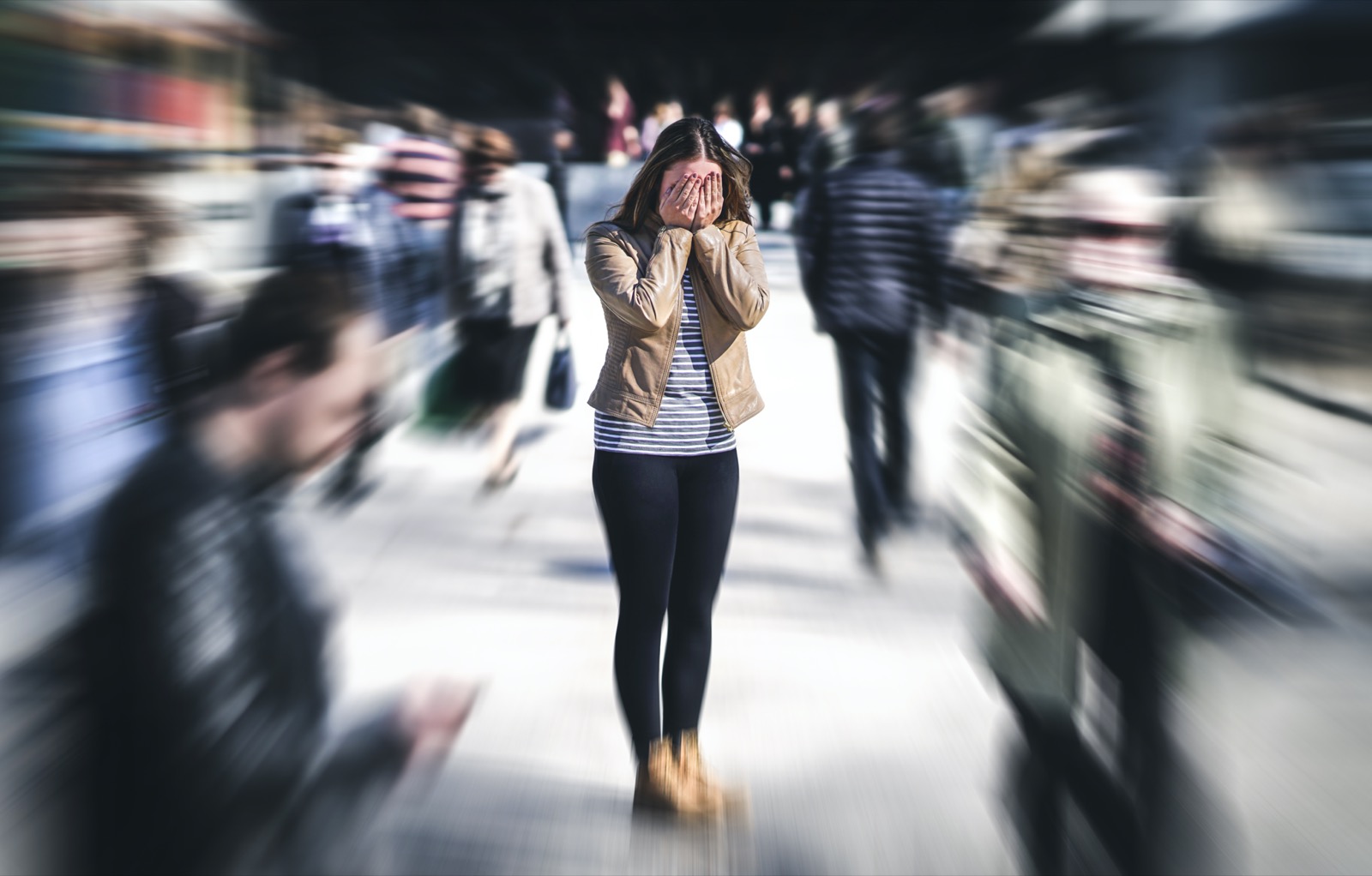The Colorado beetle that threatened the potato crop of the former GDR in 1950 might have been an American method of sabotage against the Eastern bloc. A sinister German plot might have been the cause of the Spanish flu. Perhaps AIDS emerged as a biological weapon developed by the United States and has been tested on prisoners and minorities. Every crisis humanity has ever faced has had its own conspiracy theories and its own conspiracy theorists.
“It’s fake. If you go on Youtube, you will see the speech made by the head of the IMF, the one she gave a month and a half ago. She was warning that the pension fund is going to collapse because there are too many old people on the planet. Especially in Italy”, a self-assured man explains to TV journalists.
It is not only the old or easily misled who believe and spread theories suggesting that COVID-19 is a hoax or a treacherous tool intended to kill undesirable members of Earth’s population. On the contrary, we see these theories thriving even on the Facebook walls of young people, and with people who have had more than a shade of education.
We all have our own prejudices. We look for the “truth” inside our own bubbles, giving deference to information that integrates harmoniously with views we already hold. Our phones are invaded every day by news that misinforms and reinvents reality, leaving us in an echo chamber.
In this digital age, the coronavirus pandemic has created the ideal conditions for misinformation, unverified stories, and conspiracy theories to snowball together. These do not empower us to deal with the crisis.
Checking the credibility of our sources of information
A speech in which Christine Lagarde, the head of the International Monetary Fund, allegedly declared that “the elderly live too long” has been circulating on social networks for at least two years, provoking the most indignant reactions.
In actual fact, the statement made by Lagarde dates back to 2016, and focuses on the economic and social consequences of population decline and aging. The statement was published on the IMF’s website and has none of the “aggressiveness and cruelty” mentioned by one of the other distributors of the statement—a website that managed to attract 23,000 views to its article and which is quite fond of fake news.
An entire fake-news and click-bait industry has emerged, financed by companies that see no problem in placing their ads next to false headlines.
In the past few months, journalists have identified several networks of websites that imitate reputable news sites. These websites have two common characteristics: they act in groups, and get money from running click-bait stories. Topics covered include weight loss diets, diet tips, and oversimplified political news. There is often pro-Russian propaganda on these sites, taken from the Sputnik news agency. Spiced with a lot of fake news, this information mix is then shared on Facebook pages that have thousands of followers.
This phenomenon is also mentioned in a study by the Center for Media, Data and Society at the Central European University, which states that there is a rising trend of such websites being created. Out of a total of 50 sites analysed by researchers, the study identified 16 that are part of propaganda networks.
The media is going through a turbulent period. Journalistic standards have begun to be treated less seriously, with the most important standard now revolving around obtaining as large an audience as possible. An entire fake-news and click-bait industry has emerged, financed by companies that see no problem in placing their ads next to false headlines.
We are talking about a business model that has nothing to do with verifiable information but only with monthly profit, emphasises Dragoș Stanca, digital media expert. Those who round off their income from distributing fake news or propaganda and conspiracy materials have nothing to do with journalism. They “have no ethical criteria,” explains Stanca, estimating that the revenue brought in for each block of 1,000 page views is between 0.8 and 1 euro for each such site.
It is not surprising that, in this battle for clicks, several sites announced the first case of coronavirus in Romania before it existed, or spread false reports of Romanians who have already died in Italy, infected with COVID-19. Equally, no one is shocked by the fact that, on various sites, next to articles describing miraculous and almost instant cures for the most chronic diseases, there are also articles that promise to “reveal the truth” about the coronavirus pandemic.
Slaloming between the conspiracy explanations about COVID-19
The new coronavirus is nothing more than a biological weapon invented in a laboratory: this is one of the theories that saturates the internet. The information was originally published by a far-right website, Zero Hedge, which published the name, photo, and contact details of a Chinese researcher in an article that ‘wondered’, right from the headline, if he was not the man behind the coronavirus pandemic. The article was signed under the pseudonym Tyler Durden and invited those who would like to know how this pandemic broke out to pay a visit to the scientist. Due to this false news, but also due to previously circulated fake news, Twitter banned Zero Hedge’s account (which had 670,000 followers).
A study recently published in the prestigious journal Nature showed that the new coronavirus, along with SARS, MERS, and other viral strains, is part of a family of seven coronaviruses, and was not created in the laboratory and is not a virus intentionally manipulated by humans.
A 2015 report by Italian television RAI is also circulating on the Internet, describing a virus created in a laboratory, resembling the false stories about COVID-19. The artificial virus created in 2014, SL-SHC014-MA15, was designed to assess the danger posed by bat-sheltered coronaviruses. The authors concluded that their work “suggests a potential risk of SARS-CoV re-emergence from viruses currently circulating in bat populations.”
We already know that this virus has nothing to do with COVID-19. “Phylogenetic analyses performed by several international groups have identified differences between SARS-CoV-2 and SL-SHC014-MA15 (the coronavirus with the sequence SHC014, the one the Nature report discussed) covering more than 6,000 nucleotides, which do not appear only in a certain part of the genome, but are scattered throughout the genome, which makes it extremely unlikely that SARS-CoV-2 comes from the artificial virus SL-SHC014-MA15 ″, Dr Robert Ancuceanu said for ST Network. Studies confirming this conclusion can be found here and here.
The theory stating that the virus was man-made has a few versions, one claiming it to be the work of the Americans, not the Chinese. Igor Nikulin, a biochemistry expert in the Russian military, has claimed that it was a virus manipulated by the Americans and that he has indirect evidence of this.
However, this has not prevented the theory from circulating and being further distributed and read, as with all other theories. Conspiracy theories abound, from the one that links the emergence of the new coronavirus to the expansion of 5G mobile technology to the theory that Bill Gates funded the creation of COVID-19, or the claims that the new coronavirus is no more dangerous than a common flu.
That last theory was recently promoted by American radio presenter Rush Limbaugh, who stated in one of his shows that the “truth” is that the common flu and COVID-19 are one and the same, and that this “crisis” is being used to bring Donald Trump down.
The potential for a lie to spread has increased dramatically in the digital age. A study published in 2018 in the journal Science showed that between 2006 and 2017, there were around 126,000 rumours distributed on Twitter. The most popular 1% of fake news typically reaches groups of between 1,000 and 100,000 people, while true news rarely reaches more than 1,000 people.
Around half of Americans say they have encountered news that misinformed them about COVID-19. At the same time, 29% believe the new coronavirus was created in a laboratory, according to a recent study by the Pew Research Center.
The pandemic is proving to be fertile ground for conspiracies. Recognising this convinced the researcher John Cook, from George Mason University, to publish The Conspiracy Theory Book earlier than he had planned. “Once we saw all the conspiracy theories and misinformation flying around the new coronavirus, and that this endangers the public, we thought, ‘There’s no point in waiting a month if we can get ready sooner,'” Cook said.
A number of factors make the public vulnerable to conspiracy theories, particularly feelings of helplessness, and the attempt to regain lost control, Cook explains.

People have a desperate need to understand what’s going on, to find a cause for the crisis they’re in, and conspiracy theories seem to give them that explanation. Many have deceived themselves into thinking that they are regaining control when they conclude that a handful of conspirators have created a deadly virus in a laboratory.
Together with the psychologist Stephan Lewandowsky, Cook made a list of seven features of conspiratorial thinking.
First of all, those who juggle conspiracy theories believe in ideas that are mutually exclusive. For example, there are many who believe that Princess Diana was murdered, but also agree with the scenario in which she would’ve staged her own death.
Second, conspiratorial thinking is automatically suspicious of any official information, generally rejecting anything that contradicts the conspiracy theory.
Third, conspiracy theorists are convinced that the alleged conspirators are acting towards nefarious ends, and never with a benevolent or neutral motivation.
Fourth, even if they may occasionally abandon certain ideas that prove impossible to sustain, the conspiracy theorists persist with their final conclusion that “something is still rotten.”
Fifth, people attracted to conspiracy theories have a self-perception that places them in the contradictory position of both victim and hero.
Sixth, conspiratorial thinking proves to be immune to evidence—the stronger the evidence challenging a conspiracy theory, the more convinced its followers are of the truth of their version of events.
Finally, conspiratorial thinking is prone to reinterpreting random, unrelated events, setting them into a larger picture that gives them a particular logic.
Exiting the vortex of false theories
“A gram of prevention is worth more than a kilogram of treatment.” This is an important principle that we must take into account when trying to dismantle conspiracy theories, Lewandowsky and Cook argue.
When false theories have taken root, we need to dismantle their reasoning, and the most effective weapons with which to do this are the presentation of facts (the use of logical arguments with an empathic approach, the only one that leads to real dialogue) and developing methods to cognitively empower others, such as encouraging them to rely on analytical thinking rather than intuition.
In addition to the epidemic generated by COVID-19, we are facing an “infodemic”: a constant flow of news—some accurate and some not—according to the World Health Organization (WHO), which has created a special site to dispel a series of myths circulating about the methods of spreading and treating the new coronavirus. Dumitru Borţun wrote extensively and eruditely about how we can identify false news. There are some clear indications that a site is not reliable: the information it publishes is not found in credible publications, and usually the sources of information are not cited (or they are anonymous or impossible to find in reality). Some do not show the contact details of the editorial team. Last but not least, it is important to consider that “headlines have a powerful emotional impact and cause panic”. Sometimes, when accessing such sites, the reader can only see the title and the image of the “news”, and in order to access the full content he is first obliged to distribute it on social networks.
Those who access the site created by the WHO find out, for example, that despite the contradictory information that pervades social networks, COVID-19 survives even in areas with warm climates, and cannot be destroyed by frost or snow or by lamps with ultraviolet light, hot baths, garlic consumption or saline nasal washes, just as antibiotics cannot treat or prevent infection with the virus.
If a feeling of helplessness predisposes people to fall into the trap of conspiracy theories, the feeling that they have access to the right perspective on what is happening can give them a comforting—albeit false—sense of security. And this can make them neglect or even fight against any responsible safety measures imposed. When you are in the middle of a fire, you first put it out and then “learn the lessons.” If we try to reverse the order, we may notice too late that the fire has engulfed our house. In trying to float above the fearful, planetary hum, we may fail to see that our wings are even more fragile than those of Icarus. Let’s not be so eager to expose our supposed enemies that we are unable to recognise our allies.
Carmen Lăiu is a writer for ST Network and Semnele timpului.



















